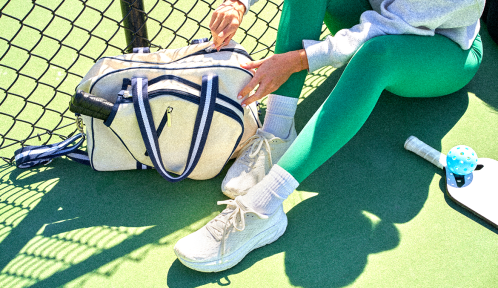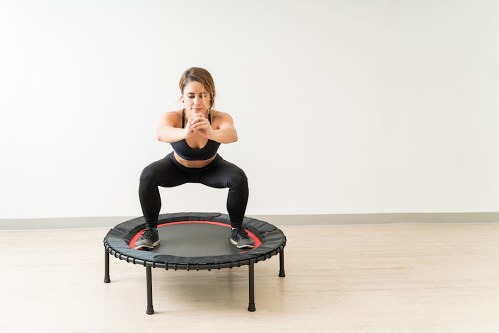Our editors independently select these products. Making a purchase through our links may earn Well+Good a commission
The desire to try workouts on a trampoline has been increasingly prominent in my mind lately. For the uninitiated, trampoline workouts are what they sound like: jumping on a trampoline for exercise (though the trampolines are smaller, and the movements are more specific). My interest may have come from all the fun-looking Instagram reels and photos of group trampoline classes, or my thirst for trying new workouts, or—let’s be real—an ache to have kid-like fun again in the midst of so much “adulting.”
Experts in This Article
certified fitness instructor, professional dancer, and co-founder of The Ness
founder of The Ness in New York City
Whatever the reason, I finally decided to bite the bullet. Carpe diem, right? And spoiler alert: I’m so glad I did.
I’m not the only person who’s curious about this practice, either. According to Google Trends, searches for fitness trampoline are on the rise, up 60 percent in just the past few days. This could be, in part, because experts believe it’s an enjoyable, unique activity that can be notably beneficial for your physical and mental health (which we’ll get to in a bit).
What my first trampoline class was like
For my online classes and trampoline, I decided to look into The Ness, the first trampoline fitness company I’d heard of, though there are other brands that offer rebounding or bounce classes (two other names you’ll hear these classes called often), including obé, body by Simone, and LEKFIT, a rebounder studio that celebrity trainer Lauren Kleben started out of her garage in Los Angeles.
While based in New York City, The Ness has tons of online workout classes that are a “dance-based, movement-focused fitness method” you can enjoy at your own pace, according to their website. As someone who loves a good Zumba class and appreciates being able to take breaks when I need to, I thought The Ness was a perfect fit for me.
“I love the trampoline because it’s really low-impact, but it’s not lacking in intensity,” Colette Dong, co-founder of The Ness, previously told Well+Good. “So it’s really high adrenaline, it’s very much still cardio, and it gets your entire lymphatic system draining and moving,” she says. “When you go up your weight lifts, and when you go down you’re three times your weight, so with every bounce you’re pumping that lymphatic system.” So bouncing helps your internal detox process work more optimally to eliminate cellular waste, bacteria, and pathogens, while reducing inflammation, staving off disease, and promoting good digestion.
Here’s what a trampoline workout looks like to give you a sense:
Once I asked for and received a trampoline from The Ness, I immediately put it together in my backyard. I have to admit I got a little high off of the fact I built it myself (though it was so easy, this wasn’t quite a feat). Then, I looked through the catalog of classes on my laptop, picking Lil’s “simple bounce #2,” which is 20 minutes. (I didn’t want to start off too hard at the beginning!) I set my laptop on a patio chair and got to jumping.
After a few quick jumps on the trampoline, I unlocked my inner child and felt seven years old again. I mean, you hear about the importance of engaging in movements you find enjoyable, but I didn’t realize they could be that fun, you know? More specifically, I especially loved the jumping jacks and “scissor” moves in Lil’s video. Additionally, she was encouraging and played fun songs throughout, which is a crucial part of any class for me.
The trampoline and virtual workouts do take getting used to, however. I felt a little wobbly at times (which is to be expected, especially if you haven’t been on a trampoline in a while), but overall I felt safe. My bodyweight was supported, the trampoline was large enough, and Lil was reassuring.
I was surprised by how low-key hardcore it was. Before long, my legs were sore.
I was surprised by how low-key hardcore it was. Before long, my legs were sore. (For context: I don’t exercise every day and rarely do any type of strength training, but I do play volleyball and/or walk or dance fairly regularly.) I definitely had to take breaks throughout to just breathe and give my legs a minute, but this worked out perfectly since I could just pause the video. Plus, I only had to rest a couple minutes before I was back at it, so not being totally wiped out or in pain for days after (like I have been after some workouts) was nice.
Mentally, I felt a little self-conscious about the fact I couldn’t jump as quickly or as steadily as the instructor. Her jumps were so consistent and clean, and mine were…not. I had to remind myself that’s okay. I was moving my body and having fun—and that’s the point, after all! I reminded myself that this was my workout time, and I wanted to do what I needed to do to make it sustainable, comfortable, and fun.
I say all this to normalize taking breaks and opting for modifications. While movement has many benefits on mental health, I know firsthand that it can quickly get you down, too, if you compare yourself. (And on that note, I wish there was more representation of various bodies among fitness instructors.)
What I wish I’d known before my first bounce class
If you’re interested in trampoline fitness, here’s what you need to know: Trampoline classes incorporate a variety of movements. While the types of jumps vary, to start, you can also add on arm weights, for example, or simple stretches. This type of exercise is great if you want to combine strength training, cardio, balance, and learning choreography.
The health benefits are all there, too. You’ve probably already heard about how, to quote Legally Blonde: “Exercise gives you endorphins, [and] endorphins make you happy.” Furthermore, exercise helps with anxiety, mood, and other mental health conditions, and that’s in addition to the physical benefits. With trampoline fitness specifically, you’re looking at increased strength, improved bone density, better balance, a healthier heart, stress relief, and—obviously—fun.
“Moving quickly and bouncing, as we do in a trampoline workout, helps to discharge and release [stuck] energy, which also results in a release of dopamine, another feel-good hormone.”—Anna Hindell, LCSW-R, therapist
“Bounce is one of the best things you can do for your body,” says Aly Giampolo, CPT, one of the co-founders and bounce instructors at The Ness. “It’s one of very few workouts that is high intensity while also being low-impact.”
So, if you experience joint pain, this may be a better way for you to get moving. “The soft mat and cords allow the trampoline to have ‘give’ so that acceleration and deceleration is absorbed,” explains Dong. “This can eliminate up to 80 percent of the shock of landing a jump, making it easier on your body.”
The “give” factor makes trampoline workouts more inclusive, which is huge. “We’ve had clients for 9+ years who started in their 40s and are now nearing [their] 50s without slowing down or missing a beat,” Dong shares. “The trampoline is also beneficial for new and expecting moms because it strengthens the pelvic floor.”
Through bounce classes, you can also release emotions and emotional discomfort that is “stuck,” so to speak. “When we are anxious or stressed out, we have stored emotions and energy in our body,” says Anna Hindell, LCSW-R, CIYT, a therapist with Choosing Therapy. “Moving quickly and bouncing, as we do in a trampoline workout, helps to discharge and release [stuck] energy, which also results in a release of dopamine, another feel-good hormone.”
I noticed this myself. Jumping immediately made me feel happier, and it served as a distraction from other worries. I released my anxious energy through movement and feel pretty good about myself after.
Hindell believes a rigorous, yet fun, workout is a fantastic way to lift your mood. And that’s just it: It makes sense that more enjoyable exercises are better for your well-being (at least in some ways), right?
Best bounce practices to keep in mind
If you have the same feelings going in that I did—excited, but also nervous about the unfamiliarity aspect—Giampolo shares tips to ease your mind.
1.Ensure your trampoline is on a flat surface
A hardwood floor, carpet, grass, and sand will all do as long as they’re flat, Giampolo says. (My backyard has a slight incline to it, which may have worsened my calf pain and wobbliness.)
2. Be mindful of how you jump
Giampolo encourages staying low, not jumping for height, using your abdominal muscles and the backs of your legs, keeping your knees slightly bent, and energizing down through your heels. (Dong shared trampoline mistakes with Well+Good, too, that are worth checking out.)
3. Modify moves as desired
You can even eliminate the bounce aspect, Giampolo says, if that’s more comfortable. The movements don’t need to be done on a trampoline.Pick the right shoe. More specifically, a tennis shoe that’s supportive, light, and fairly flat. More supportive shoes with higher platforms can make balancing more difficult, she explains. (I can confirm this, oops!)
Whether Pickleball Is Your Entire Personality or You’re an Eager Newbie, Snag These 5 Essentials to Up Your Game

Run Smarter, Not Harder: Nike’s Running Shoe Finder Takes the Guesswork Out of Choosing Sneakers

Flares! Wide-Legs! Cargos! Here Are 5 Nike Pairs to Help You Celebrate the Active-Pants Renaissance

Meanwhile, Hindell’s biggest recommendation is to listen to your body and not push yourself too hard, too fast. Build up your confidence and stamina. “Bouncing can quickly get your heart rate up, so if you are new, you want to jump and take frequent breaks,” she says. What’s more, shorter and more frequent jump sessions are best for your mental health, she adds.
Ready to get started? I recommend picking a class that’s about half the length of a typical workout for you, at least for your first bounce session. Then, you can figure out what you’re looking for, whether that’s just jumping, jumping with weights, or a mix of the two. (FWIW, Giampolo says many of her clients enjoy classes that entail both jumping with and without weights.)
Finding an exciting exercise routine for you specifically is vital. “If you want to start a workout that will also support your mental health, you need to do something that you find fun, convenient, and affordable as to remove barriers to the workout,” Hindell says.
On that note, the cost can be a barrier to bounce classes, but it feels worth it to me
While the price isn’t cheap—a monthly digital subscription to The Ness is $39.99—the quality is solid. Monthly digital subscriptions from obé ($25), LEKFIT ($34.99), and body by Simone ($19.99), are all comparable, and there are also free trampoline workouts on YouTube you can try at home. The biggest upfront investment is buying a trampoline—the most popular brand by far for bounce studios are Jumpsport trampolines, which start at about $240. FYI, most of the proprietary trampolines studios offer are produced in partnership with Jumpsport. For example, The Ness trampoline is $499.99 and desigend by them. So one way to save yourself some cash is by purchasing a trampoline first or second hand online.
Ultimately, I do think it’s worth it. Trampoline workouts are more intense than I expected, but I did have a lot of fun. Plus, I’m guessing some of the trickier parts—like balance and mental comfort—will get easier as I do more bounce sessions. Next time, I plan on incorporating more of the moves I enjoyed and less of the ones I didn’t.
I also plan to keep reminding myself that exercise isn’t about “looking pretty,” it’s about having fun and feeling good. And let’s just say that while I’ll always have a special place in my heart for volleyball, I absolutely gushed to a friend earlier about how fun hopping onto my new trampoline is.
Sign up for the Well+Good SHOP Newsletter
Get exclusive deals on wellness, beauty, fitness, and food products that have been hand-picked by our editors.
Got it, you've been added to our email list.







